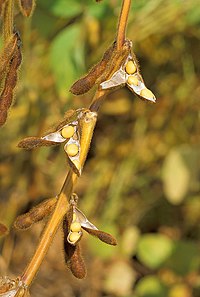
Photo from wikipedia
A 63‐day growth trial was conducted with northern snakehead Channa argus to evaluate how rapidly its growth performance and how reproducibly its gut microbiota respond to different dietary protein sources.… Click to show full abstract
A 63‐day growth trial was conducted with northern snakehead Channa argus to evaluate how rapidly its growth performance and how reproducibly its gut microbiota respond to different dietary protein sources. Four diets were formulated with different levels of soybean meal as a replacement for fishmeal (0%, 25%, 50% and 75%). Each diet was fed to three replicates of juvenile C. argus (30 juveniles per replicate, initial weight 8.65 ± 0.25 g) to produce groups G1, G2, G3 and G4 respectively. During this trial, survival rate, growth performance and intestinal microbiota composition were determined on days 9, 21 and 63. At day 9, there was no effect of the dietary soybean meal on the final weight (Wt), weight gain (WG) and specific growth rate (SGR) between the four groups (p > 0.05). However, at day 21 (p < 0.05), they were significantly lower in G4 fish than that in G1 and G2. The highest Wt, WG and SGR were found in G1 and G2 fish, the lowest growth was found in G4 fish at day 63 (p < 0.05). Furthermore, higher operational taxonomic units (OTUs) and alpha diversity were found in G4. With the dietary soybean level increased, the proportion of Firmicutes, Bacteroidetes and Verrucomicrobia, as well as some genera of bacteria (Carnobacterium, Cetobacterium, Planctomyces, Shewanella and Thermomonas) significantly increased in the G3 and G4 fish (p < 0.05). However, the OTUs, Chao index, and the proportion of Firmicutes and some genera (Acinetobacter, Bacillus and Geobacillus) in G4 fish were significantly higher at days 21 and 63 than that at day 9 (p < 0.05). Taken together, in response to dietary soybean meal levels, dynamic and significant changes in microbiota occurred, which then ultimately attained a new equilibrium.
Journal Title: Aquaculture Research
Year Published: 2019
Link to full text (if available)
Share on Social Media: Sign Up to like & get
recommendations!